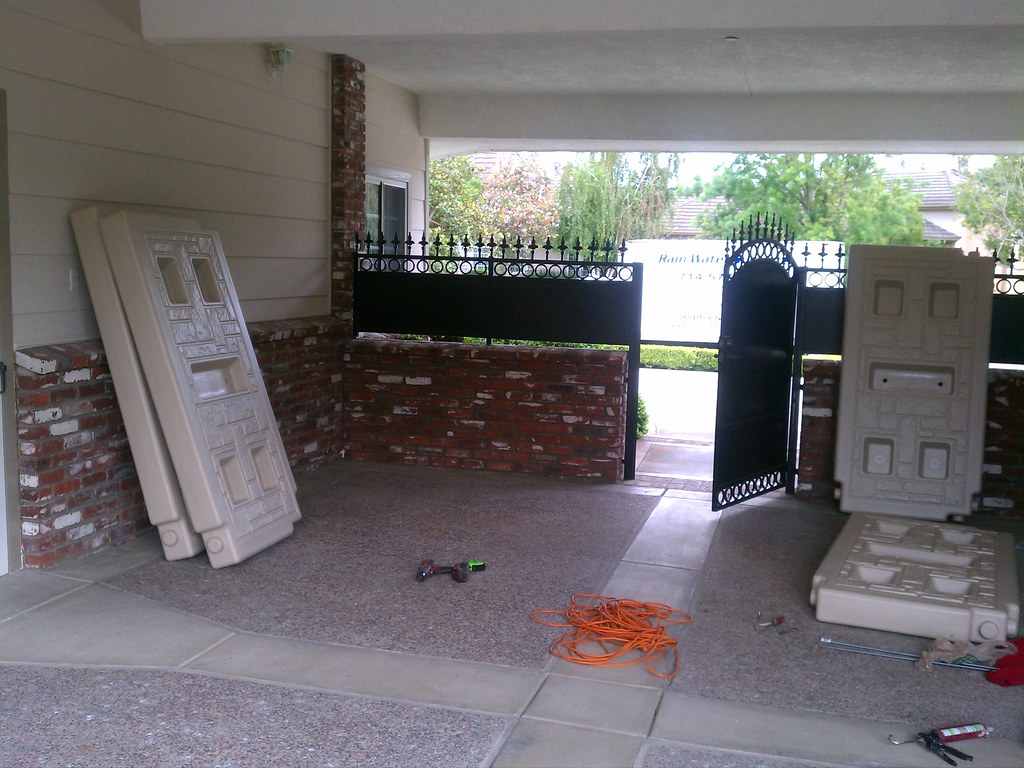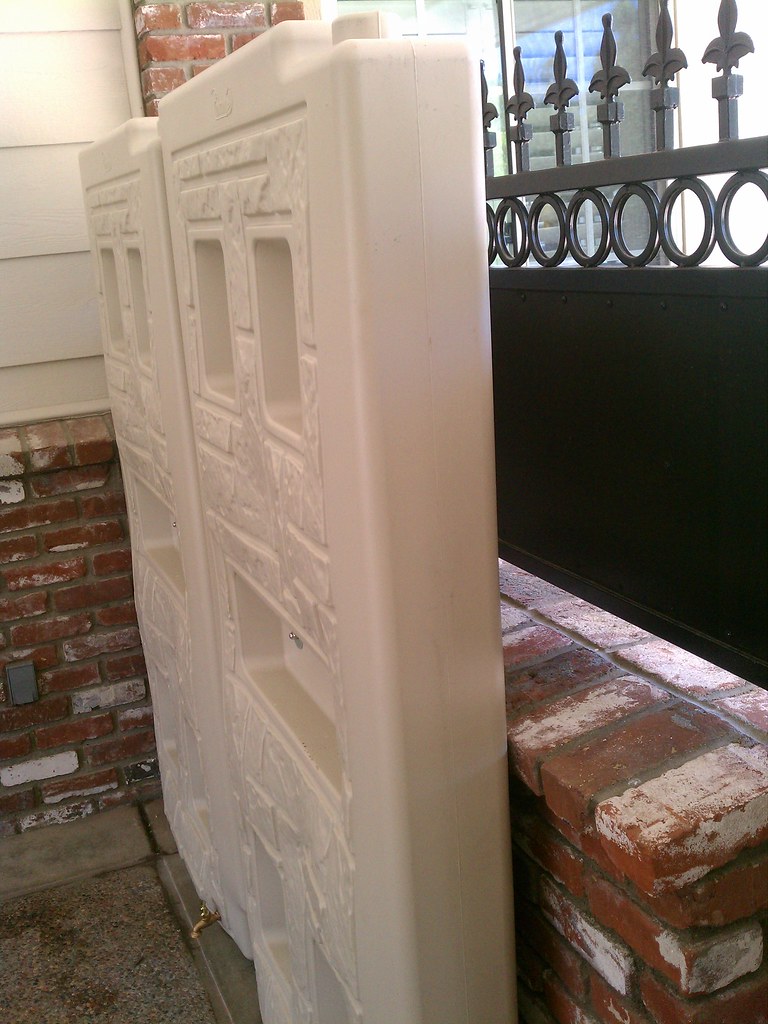Tweet
These are manufactured by Contain Rainwater Systems and have a few cool features; they have two ways that they can be mounted with one side having a rock looking texture and the other side having a modern look. They were simple to mount, even on this odd brick surface. There is a factory installed tap that a plastic spigot can thread into, and they can be linked together for larger capacity. They come in two colors and are in stock in quantity and available for prompt shipment. Please email about cost. If you mention the term " Emergency Water Storage " in your email you will receive a special introductory price. I am interested in dealers outside of California who wish to buy on a wholesale rate. Please contact myself or Eric.
They are FDA approved safe for potable water and in addition to being an excellent option for rainwater harvesting where there is very little room I think they make a great option for emergency potable water storage. Large round barrels take up too much storage space, and these are designed to mount to a wall, out of the way. I am recommending that earthquake country people have one of these for each member of their family mounted in a cool dry place, such as a basement or garage. Each tank holds around 70 gallons which can be rationed to a comfortable three month supply per person. Water stores for a long time if not contaminated by an outside source but we suggest they be drained and refilled once a year.
We installed four in a breezeway on a house in Yorba Linda. The homeowner liked the idea that the 6'6" height provided added privacy. They are for use in case a large Earthquake disrupts Southern California water supply ( which is going to happen at some point ). As I have made other posts about The California Katrina and the Central valley delta system levee danger I will not belabor the point again but I cannot encourage people strongly enough to have some sort of collection and storage set up for an emergency water supply.
Eric Konechny is the United States division chief and designer of these tanks and I can personally attest to the fact that he will go above and beyond to help me get these tanks to you promptly. My business Rain Water Systems is an authorized distributor of these and other Rainwater Harvesting Products and my role is to not only test and install these systems but to train other small businesses in sales and installation and web marketing. Soon we will offer more instructional articles and DVD's as well as low cost websites purpose constructed to help market these products. These times require creativity and diversification. Trust me, in two years every scruffy gutter guy will be a rainwater harvesting expert. Not because of passion, but because the homeowner will be asking more and more for quotes on these products as it seeps into the conscious. The victors will be the companies that get experienced now and one way to do that is to offer these products to your clients now. Get a head of the curve.
Any rain gutter installation company is invited to call me on my cell and if you are in Southern California I will bring a display package to you and explain how it works and how I have been able to sell large systems. Gutter supply houses should consider hosting a seminar on harvesting rainwater; I will bring my educational display trailer with a pump, first flush device and different sizes of tanks from these new super slimline to a selection of round tanks from Bushman. I will go out with you or your customers on your first site evaluation or estimate and discreetly assist you in planning the system and pricing it. If you order your product through me I will come to your first installation and train your crew, for FREE. Who else is going to do that our has the experience, relationships and portfolio to back it up?
These are manufactured by Contain Rainwater Systems and have a few cool features; they have two ways that they can be mounted with one side having a rock looking texture and the other side having a modern look. They were simple to mount, even on this odd brick surface. There is a factory installed tap that a plastic spigot can thread into, and they can be linked together for larger capacity. They come in two colors and are in stock in quantity and available for prompt shipment. Please email about cost. If you mention the term " Emergency Water Storage " in your email you will receive a special introductory price. I am interested in dealers outside of California who wish to buy on a wholesale rate. Please contact myself or Eric.
 |
| Click the photo to enlarge |
They are FDA approved safe for potable water and in addition to being an excellent option for rainwater harvesting where there is very little room I think they make a great option for emergency potable water storage. Large round barrels take up too much storage space, and these are designed to mount to a wall, out of the way. I am recommending that earthquake country people have one of these for each member of their family mounted in a cool dry place, such as a basement or garage. Each tank holds around 70 gallons which can be rationed to a comfortable three month supply per person. Water stores for a long time if not contaminated by an outside source but we suggest they be drained and refilled once a year.
We installed four in a breezeway on a house in Yorba Linda. The homeowner liked the idea that the 6'6" height provided added privacy. They are for use in case a large Earthquake disrupts Southern California water supply ( which is going to happen at some point ). As I have made other posts about The California Katrina and the Central valley delta system levee danger I will not belabor the point again but I cannot encourage people strongly enough to have some sort of collection and storage set up for an emergency water supply.
Eric Konechny is the United States division chief and designer of these tanks and I can personally attest to the fact that he will go above and beyond to help me get these tanks to you promptly. My business Rain Water Systems is an authorized distributor of these and other Rainwater Harvesting Products and my role is to not only test and install these systems but to train other small businesses in sales and installation and web marketing. Soon we will offer more instructional articles and DVD's as well as low cost websites purpose constructed to help market these products. These times require creativity and diversification. Trust me, in two years every scruffy gutter guy will be a rainwater harvesting expert. Not because of passion, but because the homeowner will be asking more and more for quotes on these products as it seeps into the conscious. The victors will be the companies that get experienced now and one way to do that is to offer these products to your clients now. Get a head of the curve.
Any rain gutter installation company is invited to call me on my cell and if you are in Southern California I will bring a display package to you and explain how it works and how I have been able to sell large systems. Gutter supply houses should consider hosting a seminar on harvesting rainwater; I will bring my educational display trailer with a pump, first flush device and different sizes of tanks from these new super slimline to a selection of round tanks from Bushman. I will go out with you or your customers on your first site evaluation or estimate and discreetly assist you in planning the system and pricing it. If you order your product through me I will come to your first installation and train your crew, for FREE. Who else is going to do that our has the experience, relationships and portfolio to back it up?
 |
| erick@contain.ca |






























